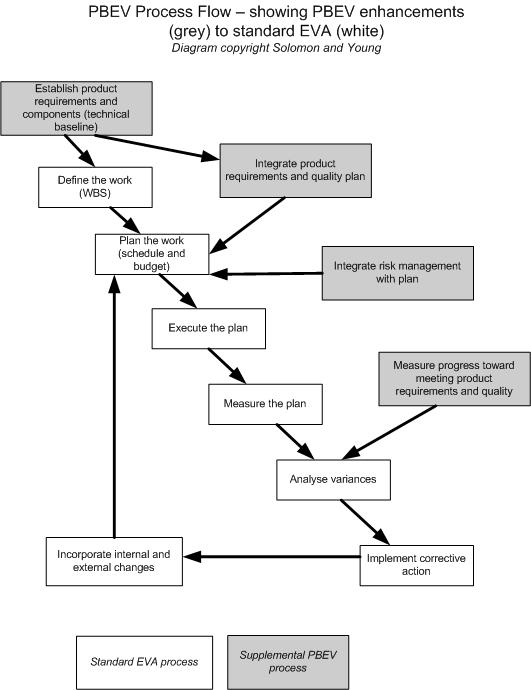This book is aimed at experienced practitioners of Earned Value Management (EVM). EVM is a technique that is used in large-scale projects and is regarded as best practice for:
- measuring a project’s progress at a point in time;
- forecasting the completion date and final cost;
- analysing variances in the schedule and budget as the project proceeds.
As the project work is completed, its value is considered “earned” from the point of view of tracking progress.
The authors contend that EVM has its limitations, namely, that it does not include guidance essential for a successful systems engineering project, namely: the integration of requirements, risk management and quality aspects. Hence, the authors propose some key enhancements to EVM that they call performance-based earned value (PBEV).
These enhancements (see diagram) are:

- a focus on tracing schedule- and cost-plans directly to a requirements baseline;
- that progress is measured by requirements completion with an emphasis on achieving the documented quality standards;
- changes to the requirements baseline result in a change to the performance baseline;
- the integration of risk management to the baseline plan.
The authors claim that these modifications give PBEV the flexibility to be used for agile projects, and also those where evolutionary acquisition techniques are planned. The key elements to this flexibility are:
- using PBEV only after the several iterations of stakeholder-supplier interaction to obtain a solid requirements baseline on which to plan;
- using PBEV on only critical elements of the project;
- to minimise the number of work packages being tracked.
The agile approach is further discussed in the chapter describing
software-intensive projects – ie those biased toward software
engineering rather than systems engineering. As is to be expected, there
is little mention of use-case- or scenario-based methods, although usefully the adaptation of PBEV to iterative approaches is discussed in context of a worked example.
Another highly-useful section is devoted to trade studies, ie
activities that examine the marketplace for potential solutions to
system requirements. Although the example in the book details a study
for components of a system, it could be easily adapted for use for the
selection of commercial-off-the-shelf (COTS) software products.
Summary
This thought-provoking book will attract many readers. Experienced
EVM practitioners will want to read this book to see if the authors’
enhancements are suitable for their work. Although the book is written
for experienced users of EVM, there is a useful appendix on EVM basics
for those less familiar with the technique.
In addition, the book is a valuable aide-memoire
of the requirements process in complex, large-scale systems engineering
projects. It summarises how requirements are analysed and integrated in
the project plan. Requirements engineers will want to read it to
understand what metrics are required by their project board, and why.
Agile practitioners who are already using lightweight versions of EVM to incorporate into their work will find the book’s emphasis on completed requirements as the basis for earned value – is in tune with their ways of working. However, those agile practitioners who are just looking for a way to use a simplified version of EVM on their agile software project may care to look elsewhere first, then return to this book for further ideas.